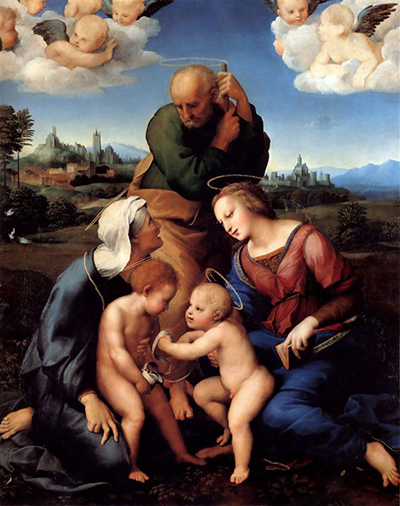The Canigiani Holy Family is an artwork by the famous Italian High Renaissance craftsman Raphael from 1508. It is a piece of the perpetual gathering of the Alte Pinakothek in Munich.
It demonstrates Elisabeth primarily with infant John the Baptist, Joseph and Mary with newborn child infant Jesus. The figures of the New Testament keep up eye contact. The oil painting was purchased from the owner by the Canigiani family in Florence Italy for their Home sacrificial table. This religious art painted on the upper piece of a bit of fretwork takes after the focal board of an altarpiece. A youthful, rotund Christ connects from his support towards the arms of the Virgin Mary, while St. Elizabeth defensively grasps the young John the Baptist in her arms, who is asking before the Messiah. A quiet and thoughtful Joseph, marginally set back, watches the Mother and Child. Two delicate holy messengers close the gathering on the left. One is holding a wreath upper Mary's head like a sacred diadem.
This sweet and dynamic creation is a strict duplicate of a Holy Family concocted by Raphael. It was dispatched by Pope Leo X, who offered it to Francis I, the King of France, in 1518. The theme of the wreath related with the Virgin was an immediate reference to Queen Claude of France's ongoing maternity. The canvas, presently kept at the Louvre, bears the mark of the Italian ace. This astonishing work without a doubt affected artisans who could appreciate it straightforwardly, or through painted and engraved duplicates. In 1522, Bernard van Orley, nicknamed the "Flemish Raphael", replicated the canvas, however, lessened the number of characters and adjusted it to Flemish culture. Specifically, he highlighted a scene out of sight and the countenance of the characters, particularly that of the Virgin, is reminiscent of the most beautiful Madonnas of the previous Southern Netherlands.
Attributable to the topics utilized by the Master of Female Half-Lengths in his works, it is expected that he worked in the favoured social milieu of the court of Margaret of Austria in Mechelen, likewise frequented by Bernard van Orley. While it is difficult to show an immediate connection between the artwork and its Italian model today, it would appear glaringly evident that the Master of Female Half-Lengths had the chance to painstakingly think about it since his variant is fundamentally the same as, regardless of various new themes.
The foundation never again opens onto a blue sky and is shut. Christ's support is less intricate, much the same as the floor where profoundly different tiles supplant the polychromatic marble clearing. The painter of half-lengths hasn't received Raphael's bright palette yet has picked more quelled and less differed tones. However, this not the slightest bit influences the general agreement of the creation. The way the faces, haircuts and drapery are painted is fundamentally the same as a Holy Family kept at the National Gallery in London and another one in Philadelphia credited to the Master of Female Half-Lengths, of a size relatively indistinguishable to our board.




